Formation Control of Multiple UUVs Based on GRU-KF with Communication Packet Loss
Abstract
1. Introduction
- (1)
- In order to achieve the cooperative control of UUV formations, a backstepping sliding mode controller based on the leader–follower method is designed by combining the relative position constraints of the leader and the follower.
- (2)
- In order to solve the problem of communication packet loss, a GRU network is utilized to predict the time series of the leader’s trajectory; then, a Kalman filter is introduced, and the predicted value of the GRU network is used as the measured value of the state in the Kalman filtering algorithm to update the leader’s state in real time. This method can optimize the control performance of the UUV formation under the influence of communication packet loss and reduce the control errors caused by external environmental interference.
2. UUV Model
2.1. UUV Linearization Model
2.2. Current Model
3. UUV Controller Design
3.1. Design of UUV Controller Based on Backstepping Sliding Mode
3.2. Design of UUV Controller Based on RBF Neural Network
3.3. Design of UUV Formation Controller-Based Leader–Follower Method
4. Design of GRU-KF-Based Formation Controller with Communication Packet Loss
4.1. Analysis of Formation Control with Communication Packet Loss
4.2. GRU-KF-Based Formation Predictive Control
4.2.1. Formation Predictive Control Framework
4.2.2. GRU Neural Network
4.2.3. Kalman Filter
4.2.4. Formation Prediction Model Based on GRU-KF
5. Simulation
5.1. Simulation and Analysis of UUV Formation Control Based on Leader–Follower Method
5.2. Simulation and Analysis with Communication Packet Loss
6. Conclusions
Author Contributions
Funding
Data Availability Statement
Conflicts of Interest
References
- Li, H.; Cui, S.; Wang, X.; Yu, B.; Wang, G.; Cao, C.; Shen, Y.; Zeng, Q. Development of a bionic jellyfish robot for collecting polymetallic nodules. Ocean. Eng. 2025, 324, 120655. [Google Scholar] [CrossRef]
- Subin Raj, V.B.; Sarun Lal, M.A.; Gowri, R.S.; Ramesh, S.; Ramesh, N.R.; Ramesh, R.; Deepak, V.; Vadivelan, A.; Ramadass, G.A. Assessment of polymetallic nodules in the Central Indian Ocean Basin: Factors influencing distribution patterns through high-resolution autonomous underwater vehicle (AUV) survey. Geo-Mar. Lett. 2025, 45, 7. [Google Scholar] [CrossRef]
- Zhu, H.; Chen, J.; Lin, Y.; Zhou, P.; Wang, K.; Lin, P.; Peng, X.; Li, H.; Guo, J.; Ren, X.; et al. The application of structured light for external subsea pipeline inspection based on the underwater dry cabin. Appl. Ocean. Res. 2025, 155, 104431. [Google Scholar] [CrossRef]
- Sang, I.-C.; Norris, W.R. An Adaptive Image Thresholding Algorithm Using Fuzzy Logic for Autonomous Underwater Vehicle Navigation. IEEE J. Sel. Top. Signal Process. 2024, 18, 358–367. [Google Scholar] [CrossRef]
- Patel, S.; Abdellatif, F.; Alsheikh, M.; Trigui, H.; Outa, A.; Amer, A.; Sarraj, M.; Al Brahim, A.; Alnumay, Y.; Felemban, A.; et al. Multi-robot system for inspection of underwater pipelines in shallow waters. Int. J. Intell. Robot. Appl. 2024, 8, 14–38. [Google Scholar] [CrossRef]
- Feng, W.; Ma, Y.; Li, H.; Liu, H.; Meng, X.; Zhou, M. Optimal search path planning of UUV in battlefeld ambush scene. Def. Technol. 2024, 32, 541–552. [Google Scholar] [CrossRef]
- sub Song, K.; Chu, P.C. Conceptual design of future undersea unmanned vehicle (UUV) system for mine disposal. IEEE Syst. J. 2012, 8, 43–51. [Google Scholar] [CrossRef]
- Yan, Z.; Yan, J.; Cai, S.; Yu, Y.; Wang, Y.; Hou, S. Distributed TMPC formation trajectory tracking of multiple underwater unmanned vehicles with uncertainties and external perturbations. Ocean Eng. 2024, 298, 117160. [Google Scholar] [CrossRef]
- Yan, Z.; Yang, Z.; Pan, X.; Zhou, J.; Wu, D. Virtual leader based path tracking control for multi-UUV considering sampled-data delays and packet losses. Ocean Eng. 2020, 216, 108065. [Google Scholar] [CrossRef]
- Chen, Y.; Guo, X.; Luo, G.; Liu, G. A Formation Control Method for AUV Group Under Communication Delay. Front. Bioeng. Biotechnol. 2022, 10, 848641. [Google Scholar] [CrossRef] [PubMed]
- Li, J.; Tian, Z.; Zhang, H. Discrete-time AUV formation control with leader-following consensus under time-varying delays. Ocean Eng. 2023, 286, 115678. [Google Scholar] [CrossRef]
- Jiang, X.; Xia, G. Nonfragile formation control of leaderless unmanned surface vehicles with memory sampling data and packet loss. IEEE Syst. J. 2022, 17, 3026–3035. [Google Scholar] [CrossRef]
- Kuniyoshi, S.; Oshiro, S.; Saotome, R.; Wada, T. An Iterative Orthogonal Frequency Division Multiplexing Receiver with Sequential Inter-Carrier Interference Canceling Modified Delay and Doppler Profiler for an Underwater Multipath Channel. Mar. Sci. Eng. 2024, 12, 1712. [Google Scholar] [CrossRef]
- Yan, Z.P.; Pan, X.L.; Yang, Z.W.; Yue, L.D. Formation Control of Leader-Following Multi-UUVs With Uncertain Factors and Time-Varying Delays. IEEE Access 2019, 7, 118792–118805. [Google Scholar] [CrossRef]
- Saleem, K.; Wang, L.; Bharany, S. Survey of AI-driven routing protocols in underwater acoustic networks for enhanced communication efficiency. Ocean Eng. 2024, 314, 119606. [Google Scholar] [CrossRef]
- Yan, Z.; Yan, J. Self-triggered formation control of asynchronous multiple underwater unmanned vehicle under communication delay. Unmanned Syst. 2024. [Google Scholar] [CrossRef]
- Cai, W.; Ju, Y.; Liu, Z.; Zhang, M.; Lv, S. Event-triggered leader-follower communication based formation control with dual-predictor for multiple AUVs. Ocean Eng. 2025, 334, 121552. [Google Scholar] [CrossRef]
- Tang, C.; Shi, H.; Zhang, L. Trajectory planning aided unmanned surface vehicle optimization communication method with hierarchical reinforcement learning. Ocean Eng. 2024, 307, 118225. [Google Scholar] [CrossRef]
- Liu, Y. Research on Coordinated Control Methods for Ocean Surveying by Underwater Vehicle Fleets. Ph.D. Dissertation, Harbin Engineering University, Harbin, China, 2017. [Google Scholar]
- Nettari, Y.; Kurt, S.; Labbadi, M. Adaptive Robust Control based on Backstepping Sliding Mode techniques for Quadrotor UAV under external disturbances. IFAC-PapersOnLine 2022, 55, 252–257. [Google Scholar] [CrossRef]
- Du, P.; Yang, W.; Wang, Y.; Hu, R.; Chen, Y.; Huang, S. A novel adaptive backstepping sliding mode control for a lightweight autonomous underwater vehicle with input saturation. Ocean Eng. 2022, 263, 112362. [Google Scholar] [CrossRef]
- Yan, Z.; Jiang, A.; Lai, C.; Li, H. Velocity-Free Formation Control and Collision Avoidance for UUVs via RBF: A High-Gain Approach. Electronics 2022, 11, 1170. [Google Scholar] [CrossRef]
- Wang, H.; Ren, J.; Han, M.; Wang, Z.; Zhang, K.; Wang, X. Robust adaptive three-dimensional trajectory tracking control for unmanned underwater vehicles with disturbances and uncertain dynamics. Ocean Eng. 2023, 289, 116184. [Google Scholar] [CrossRef]
- Huang, C.; Xu, H.; Batista, P.; Zhang, X.; Soares, C.G. Fixed-time leader-follower formation control of underactuated unmanned surface vehicles with unknown dynamics and ocean disturbances. Eur. J. Control 2023, 70, 100784. [Google Scholar] [CrossRef]



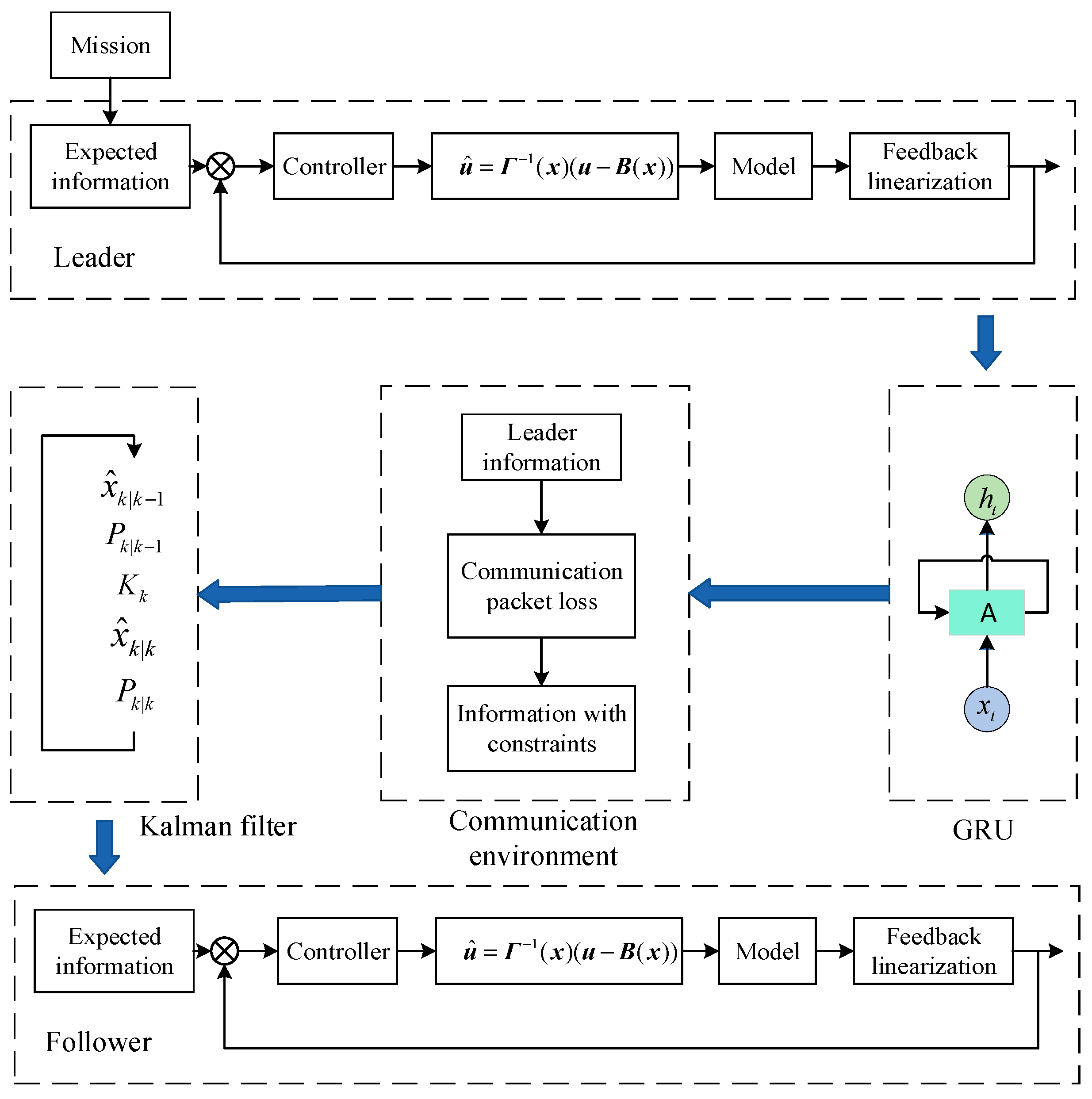
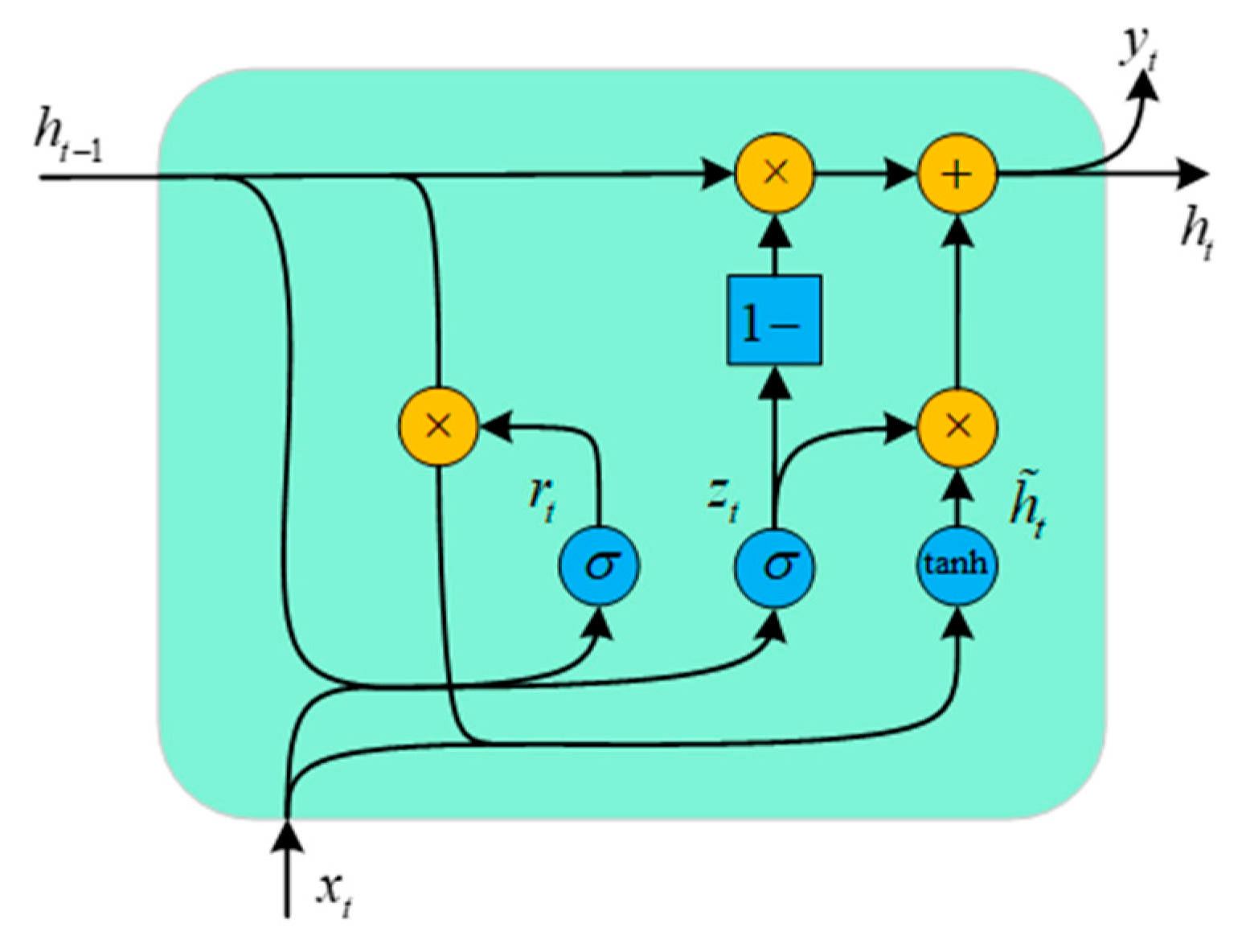
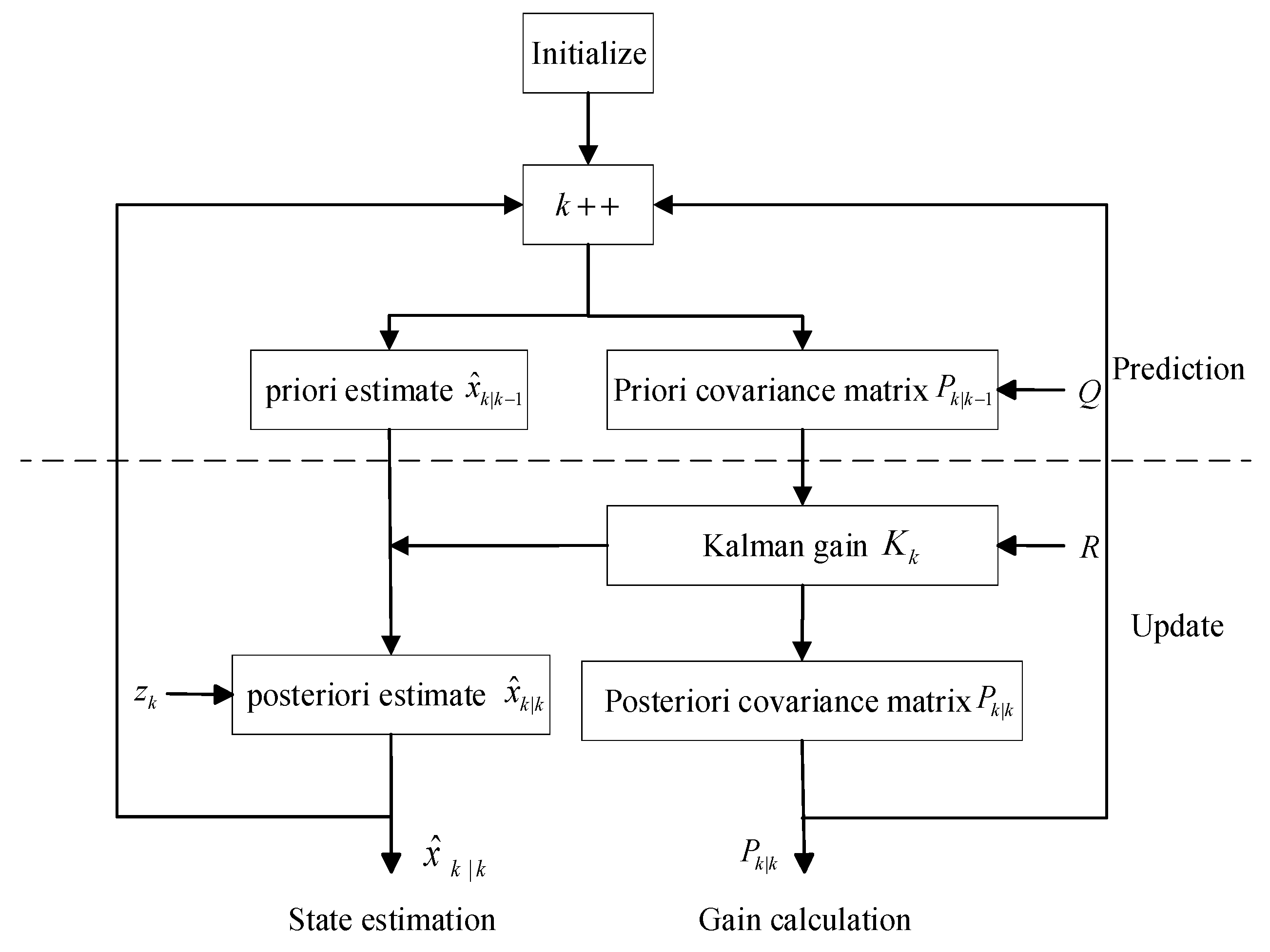

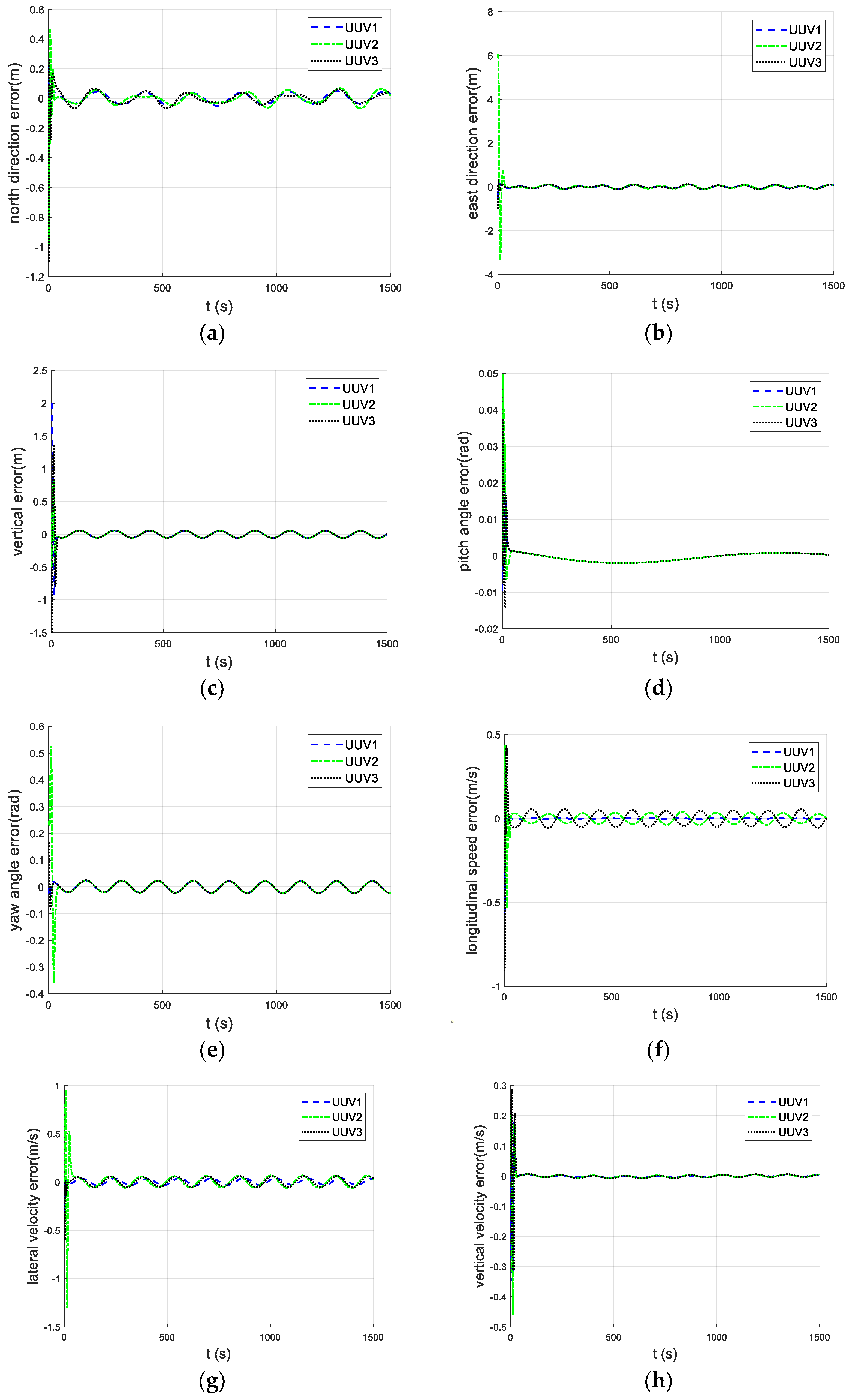
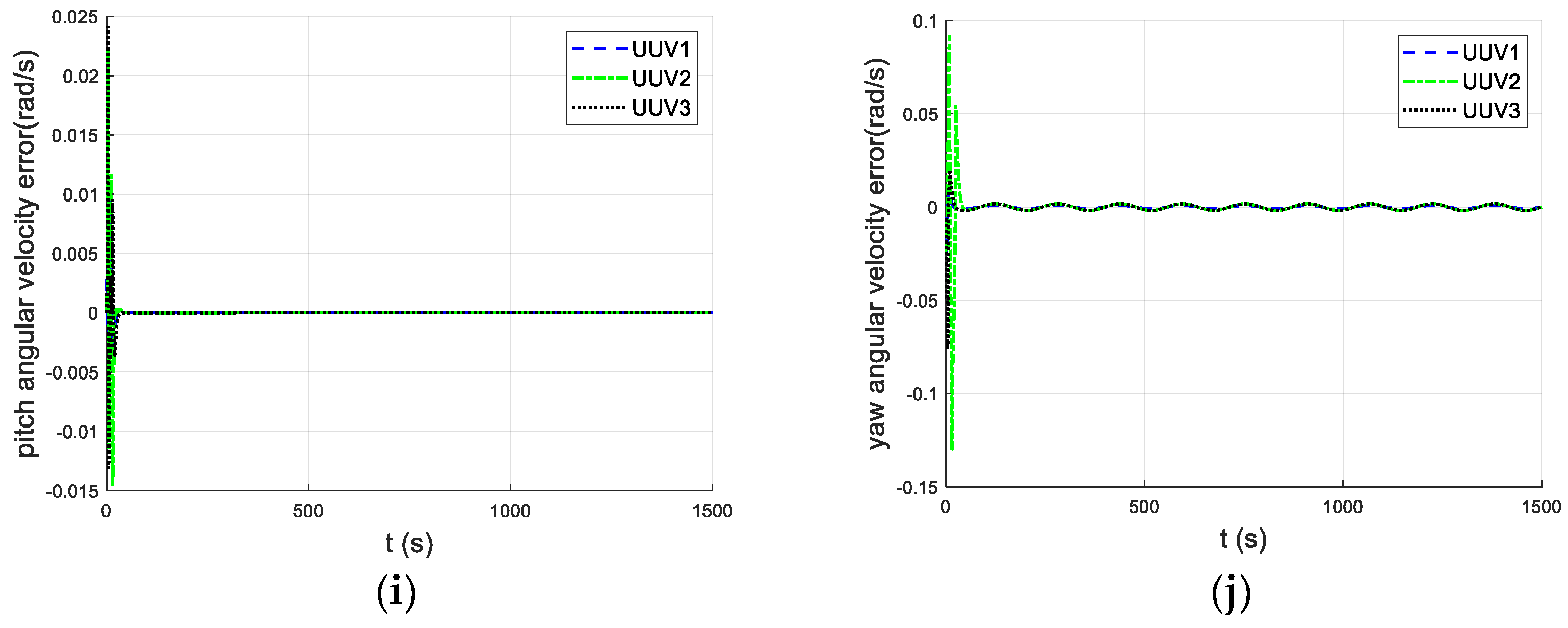

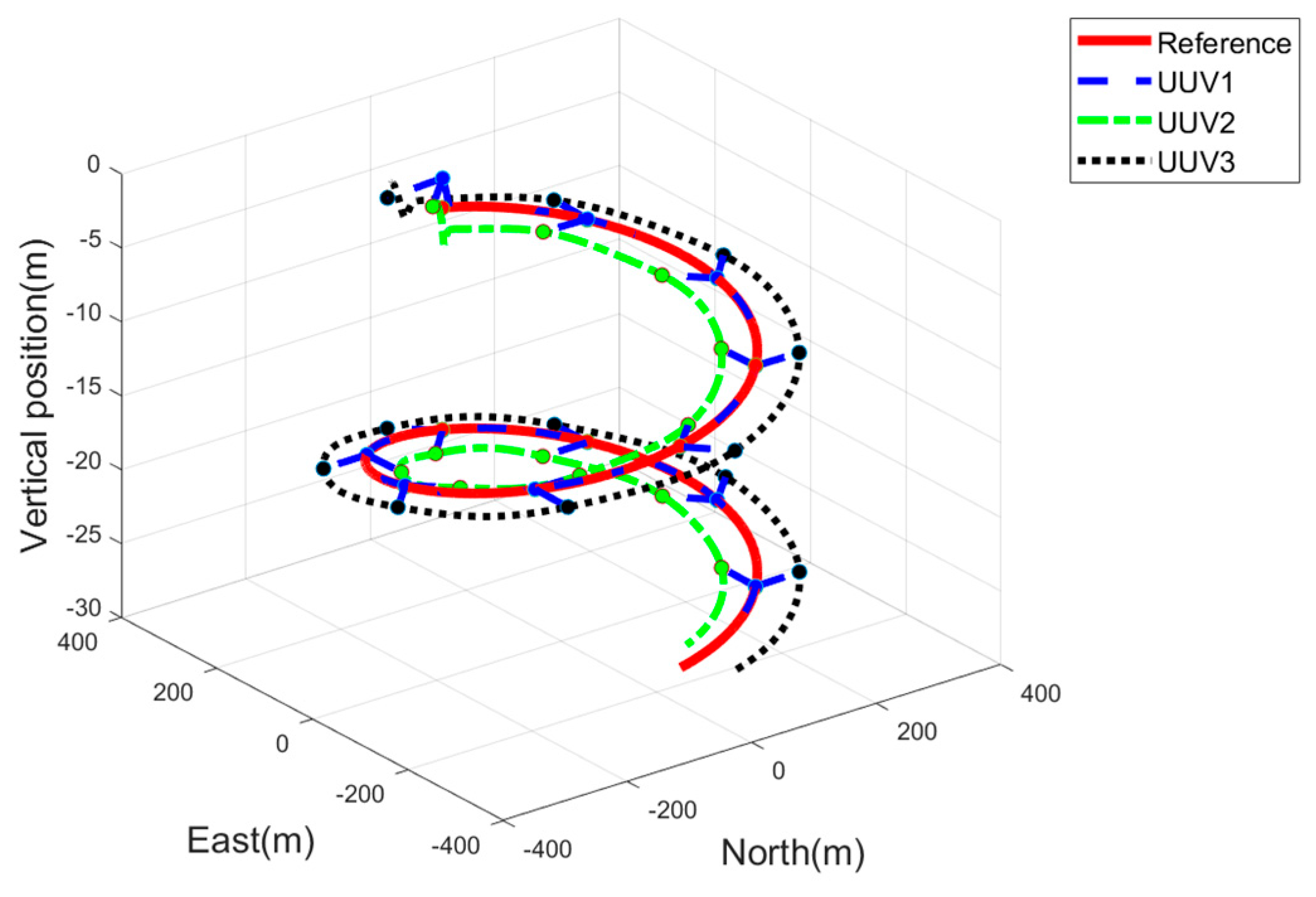
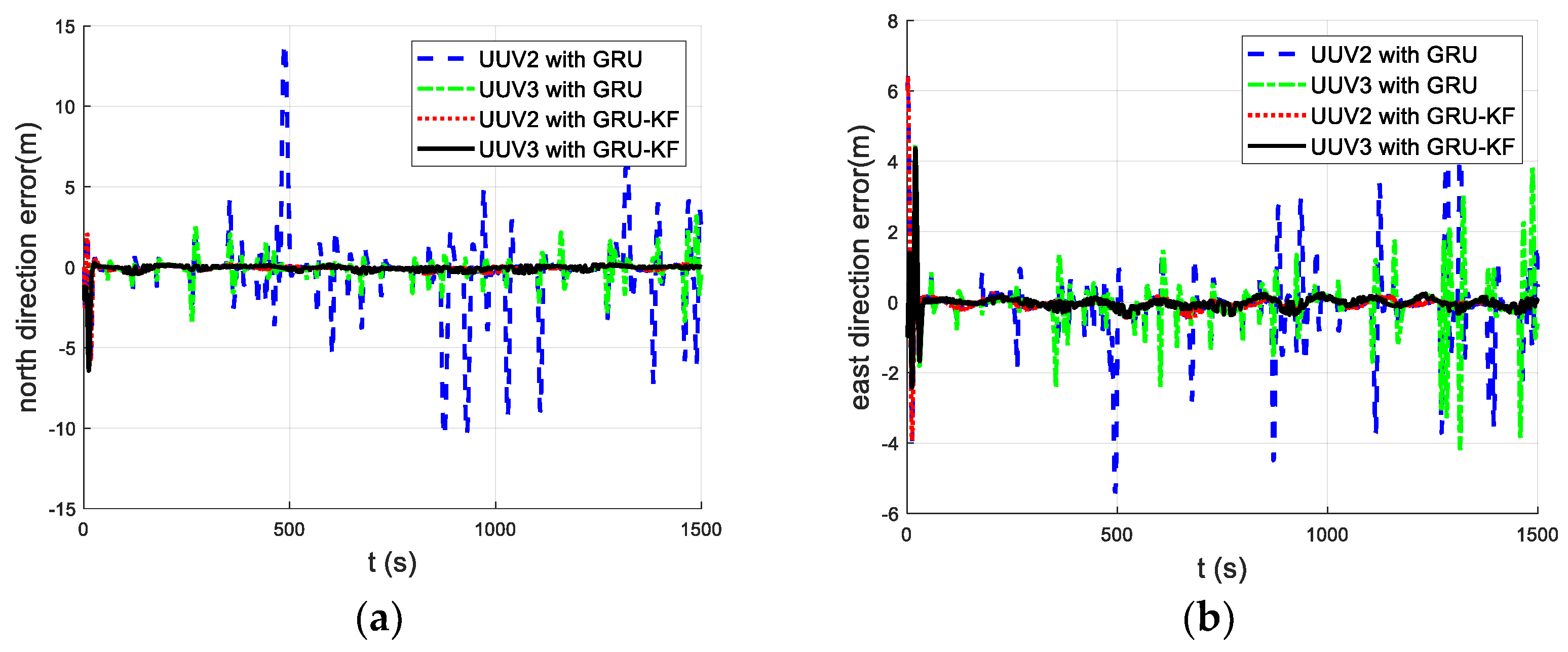
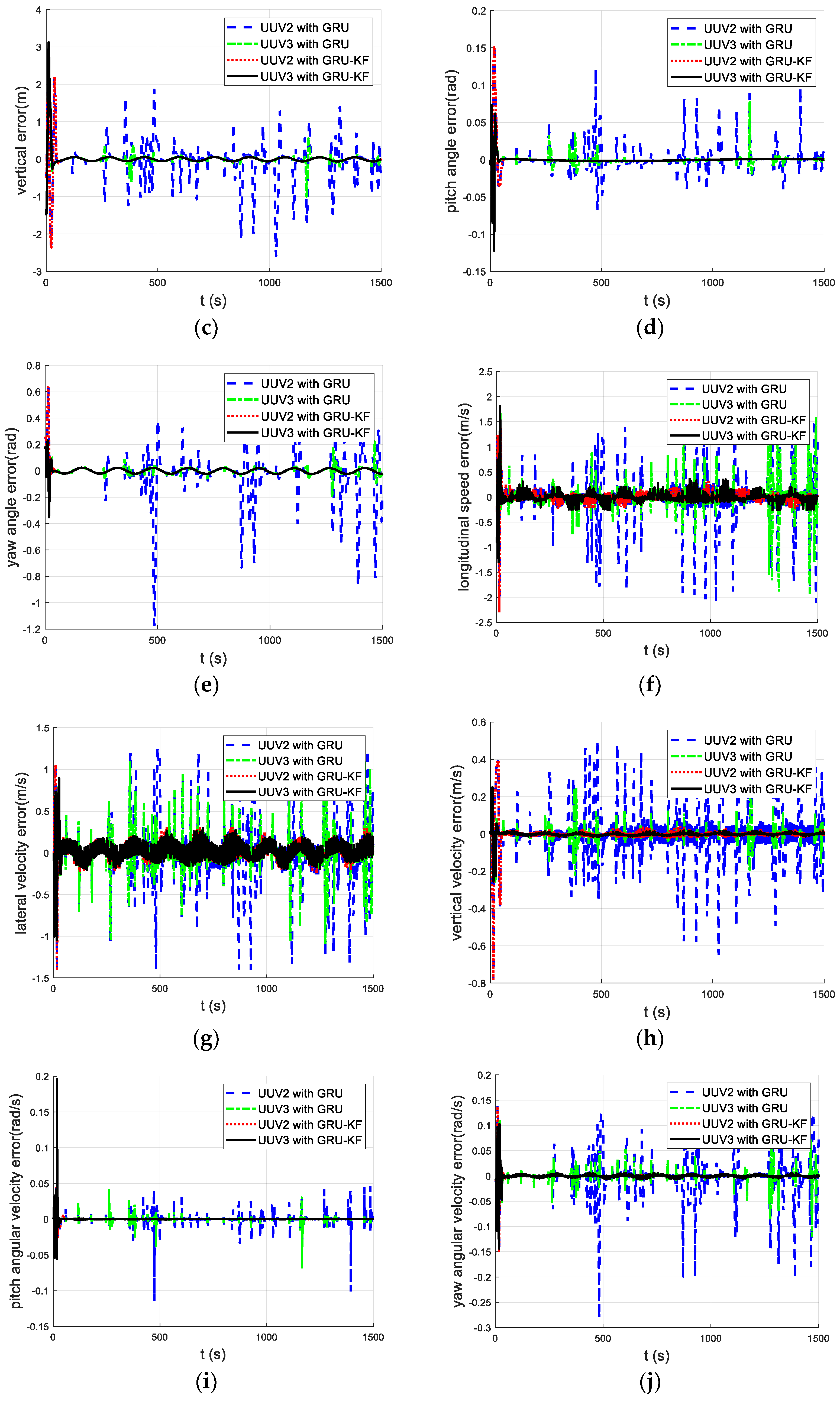
Disclaimer/Publisher’s Note: The statements, opinions and data contained in all publications are solely those of the individual author(s) and contributor(s) and not of MDPI and/or the editor(s). MDPI and/or the editor(s) disclaim responsibility for any injury to people or property resulting from any ideas, methods, instructions or products referred to in the content. |
© 2025 by the authors. Licensee MDPI, Basel, Switzerland. This article is an open access article distributed under the terms and conditions of the Creative Commons Attribution (CC BY) license (https://creativecommons.org/licenses/by/4.0/).
Share and Cite
Li, J.; Luo, R.; Zhang, H.; Tian, Z. Formation Control of Multiple UUVs Based on GRU-KF with Communication Packet Loss. J. Mar. Sci. Eng. 2025, 13, 1696. https://doi.org/10.3390/jmse13091696
Li J, Luo R, Zhang H, Tian Z. Formation Control of Multiple UUVs Based on GRU-KF with Communication Packet Loss. Journal of Marine Science and Engineering. 2025; 13(9):1696. https://doi.org/10.3390/jmse13091696
Chicago/Turabian StyleLi, Juan, Rui Luo, Honghan Zhang, and Zhenyang Tian. 2025. "Formation Control of Multiple UUVs Based on GRU-KF with Communication Packet Loss" Journal of Marine Science and Engineering 13, no. 9: 1696. https://doi.org/10.3390/jmse13091696
APA StyleLi, J., Luo, R., Zhang, H., & Tian, Z. (2025). Formation Control of Multiple UUVs Based on GRU-KF with Communication Packet Loss. Journal of Marine Science and Engineering, 13(9), 1696. https://doi.org/10.3390/jmse13091696




